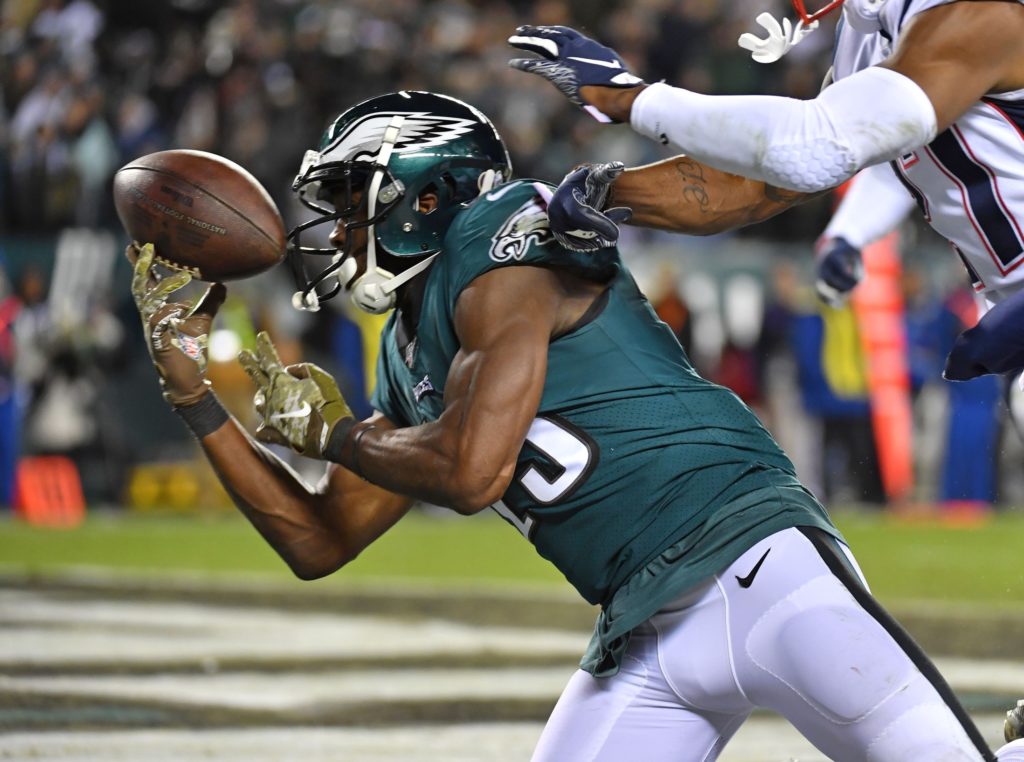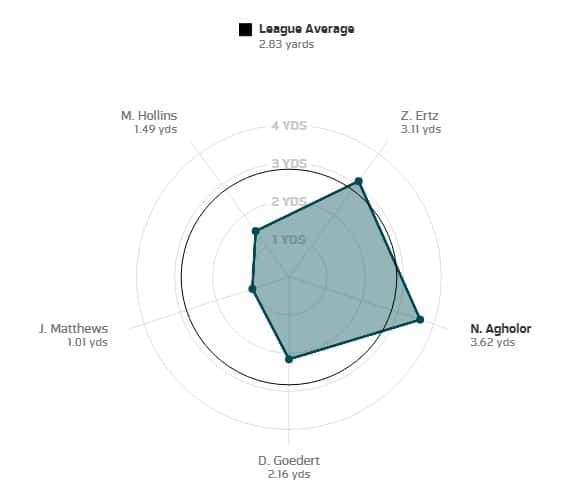Ad Disclosure
Eagles Receivers Are Posting Some (Obviously) Hideous Statistics

DeSean Jackson has more receiving yards than Mack Hollins and JJ Arcega-Whiteside despite catching a whopping nine passes this season. Pretty wild when you think about it, but not entirely surprising.
We know that the Eagles’ pass catchers have been really stinky this year, though a simple look at the numbers helps tell the story a little better. It paints an ugly picture, like whatever the polar opposite of the Sistine Chapel is.
Via Pro Football Reference, the Birds:
- have dropped 21 passes (5th worst in the NFL)
- have run for 779 yards after the catch (6th worst)
- run for 3.7 average yards after catches (6th worst)
- receivers only account for 1,008 of 2,298 passing yards (44%)
How much of that is Carson Wentz’s fault? Some of his numbers also via PFR:
- 61 bad throws this season (13th worst in league)
- 17.5 bad throw percentage (12th worst)
- hurried 35 times (24th most)
- hit 27 times (18th most)
- 17 scrambles (12th most)
It’s also on him, but not entirely. His numbers are closer to the middle of the pack than the bottom of the NFL, “unlike Agholor” and the receivers.
The NFL’s NextGen Stats page features a web chart that shows how receivers and tight ends create separation over the course of a game. With the Patriots playing a lot of man coverage on the outside this past Sunday, only Zach Ertz and Agholor were able to build separation above the league average of 2.83 yards:
If you go all the way back to week one, DeSean Jackson posted a 3.82 number, which is about a full yard above the league average and typical of what you’d find in a speed burner who can ‘take the top off’ a defense. Nobody has come close to that since.
Look further down the list of SEP numbers and you come across this for Eagle pass catchers:
- Nelson Agholor – 3.4 (tied for 14th in the NFL)
- Dallas Goedert – 2.7 (outside of the top 50)
- Alshon Jeffery – 2.5
- Zach Ertz – 2.4
Those are the only four guys that even show up on the list. It’s basically Agholor as the only guy who can really break free, and even then he’s not able to make those dynamic plays.
That’s intrinsically linked with Wentz’s penchant for throwing into tight windows, which he sort of has to do when guys aren’t typically open.
Next Gen charts this with an “aggressiveness” number of 16.3, which means that 16.3% of Carson’s passes are thrown into windows where a defender is within one yard of the receiver. There are plenty of quarterbacks with a higher AGG number, but also a higher completion percentage, like these guys:
- Dak Prescott – 18.4 AGG, 67.7 completion percentage
- Ryan Tannehill – 22.8 AGG, 71.3 completion percentage
- Sam Darnold – 16.7 AGG, 63.2 completion percentage
- Russell Wilson – 17.1 AGG, 68.5 completion percentage
Wentz is pairing that 16.3 aggressiveness rate with a 61.2 completion percentage, which is in the same region as players like Gardner Minshew, Mitch Trubisky, and Baker Mayfield. That’s not the area where you want to be living.
Put it all together and it shouldn’t be surprising that Agholor’s catch % is down nine whole points, from 66% to 57%. Alshon caught 71% of his passes last year and is down to 62% this year. Ertz is down from 74% to 64%. Those are incredibly steep dropoffs across the board, and it’s partially their fault and partially the quarterback’s fault. More than one person can take the blame, despite how Philadelphia fans and media are conditioned to think.
And yeah, Hollins and Arcega-Whiteside aren’t even really part of the equation at all. They’ve been such non-factors that there’s not enough of a sample size to parse and process. The pair this season have a combined for 168 yards on 13 receptions via 30 targets, so with Carson throwing the ball 343 times this year, he’s targeted Hollins and JJAW on just 8.7% of his attempts.
It’s really a vicious cycle in the throwing and catching department. Wentz’s receivers don’t separate very well, nor do they make tight window catches. In a display of overcompensation, he then holds the ball, tries to extend plays, and ends up throwing inaccurate passes or taking bad sacks. Everybody on the field is “pressing,” aka trying too hard, and the offense puts up 10 points at home en route to losing a winnable game.
Kevin has been writing about Philadelphia sports since 2009. He spent seven years in the CBS 3 sports department and started with the Union during the team's 2010 inaugural season. He went to the academic powerhouses of Boyertown High School and West Virginia University. email - k.kinkead@sportradar.com
